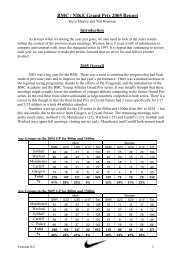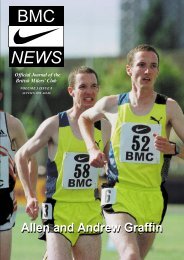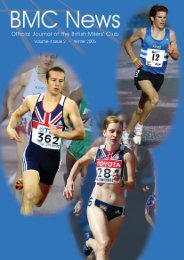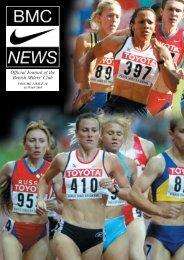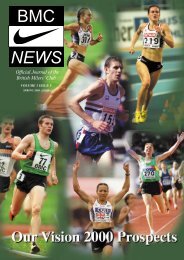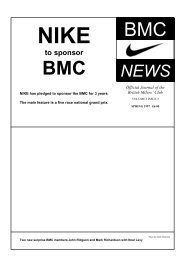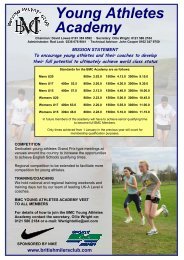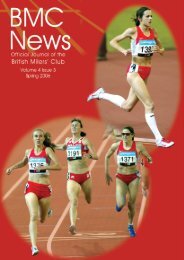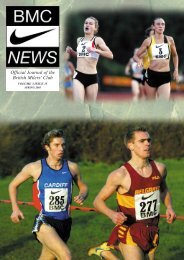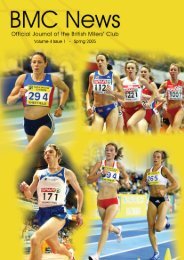Autumn 2007 - British Milers Club
Autumn 2007 - British Milers Club
Autumn 2007 - British Milers Club
- No tags were found...
Create successful ePaper yourself
Turn your PDF publications into a flip-book with our unique Google optimized e-Paper software.
Why the BMC organises paced racesby Tim BrennanLook through the summer raceschedule and you will find BMC racesup and down the country. Such is thepopularity of the races that many of ourmeetings are sold out. A commontheme in all of them is that they arepaced races.From time to time we are challenged onthis policy, sometimes by people whohave a good knowledge of the sportand a genuine belief that holding nonpacedraces would improve thechampionship racing ability of ourathletes. The argument goes thattoday’s athletes have lost the tacticalability that our runners of the past had,and that this is because they onlyexperience paced races. So why thendo we reject these arguments andcontinue with our pacemakers?The first thing to say is that our raceprogramme is geared up to thechampionships. When we sit down toplan the seasons races we look for thequalification dates of all the majorchampionships, be it the nationalschools, the Olympics or theinternational age group championships.To run in these championships yougenerally need to do well in a trials racebut you also need to have the relevantqualification time. The aim of our racesis to provide the bestpossible opportunityfor athletes to achievethese times. Theintention of the BMCraces is therefore tocomplement thechampionship racesnot to be analternative. No onewould argue that anathlete should plan arace programme thatonly included BMCraces or that aseason’s successshould be measuredonly on the timeproduced rather thanthe championshipswon.We could of coursekeep our paced raceprogramme and ontop of it organisesome non-pacedraces. If we did thishowever we would be setting ourselvesup as an alternative to the existingchampionships, leagues, and opengraded races and fighting for dates inan already busy calendar. Better then toallow the existing providers of nonpacedraces to continue. Sadly some ofthe territorial and countychampionships have declined instandard and numbers, and are badlyin need of reform or replacement.Hopefully the BMC can contribute ideason what those reforms should be, butas far as our own race programme goeswe will stick to a clear proposition ofpaced races and leave it to the athleteand coach to plan a balanced scheduleof races to best prepare for their targetchampionship.One strange aspect that I have foundwhen listening to criticism of our pacedraces is that you quite often find thecritic has never been to a BMCmeeting! Consequently they mayimagine a series of races which are aprocession of runners running in singlefile behind a pacemaker till they get insight of the line and feel safe to make adash for it. The reality is different andthere is no shortage of competitiontaking place. For a start all our racesare graded by time, meaning that anathlete is very likely to find their closestrivals lining up along side them.Pacemaking is generally to half wayand then the tactics come in to play,often with some bold front running totake the leader clear or with a masssprint finish involving careful tacticalpositioning. Probably this type of raceprovides better preparation for theinternational championships of today,(which are often fast from the start)than would be had from a slow race ina league or minor championship.So was there a Golden era now lostwhen our top runners spurnedpacemakers and consequently alwaysperformed with tactical brilliance in themajor championships? I would say notas paced competition has been themainstay of the major Europeanmeetings since at least the late 1970sand these meetings even duringBritain’s domination of middle distanceprovided the majority of the races for26 BMC News : <strong>Autumn</strong> <strong>2007</strong>



